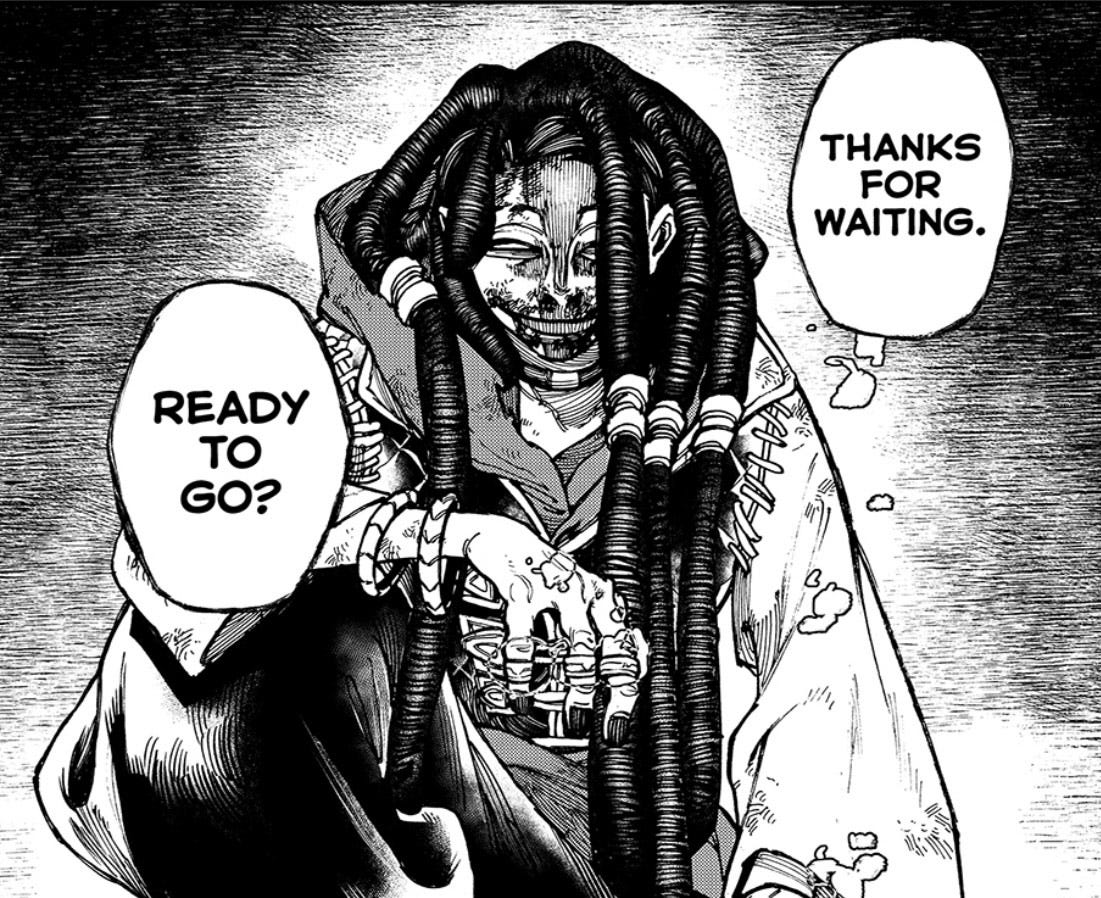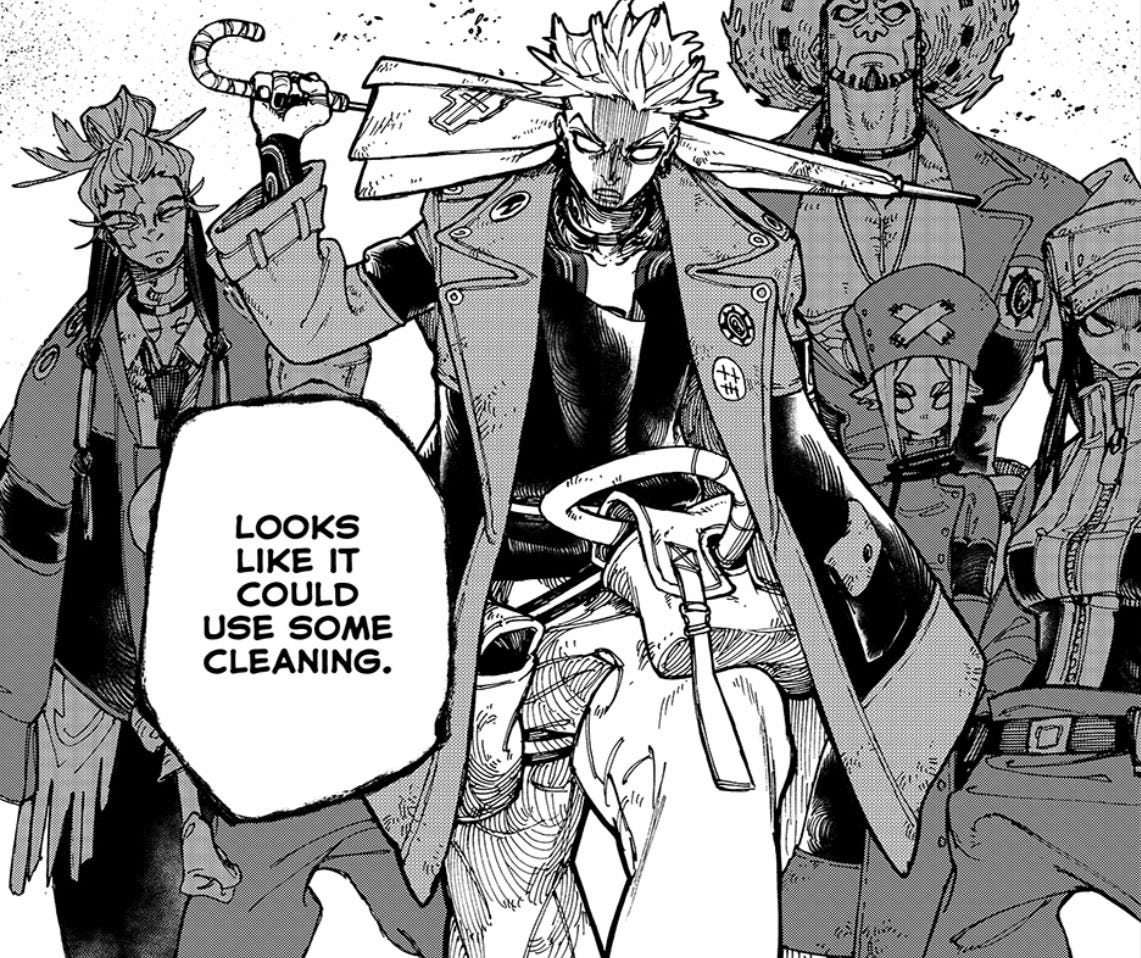Preface!
I don’t think I’ve gushed about Gachiakuta enough. It is truly remarkable. People always point to the art of series like Toilet-bound Hanako-kun to spotlight unique and praiseworthy artistic direction, and rightfully so, but add Gachiakuta into that conversation.
It’s a visual masterpiece.
From character design to facial expressions, it just stands out. It’s a cut above. And the anime adaptation (from Bones, the studio behind My Hero Academia) is going to be positively lit.
So get on board now. Obsess with me. This is a story that does practically everything right.
Preface over.
I hate setting. It’s my least favorite storytelling element. I hate it so much that I usually just skip it in the early drafting phases, and deal with it later. This worked okay-ish when I wasn’t writing in visual mediums. Turns out, when writing a script for an artist, they need to know what this dark fantasy city you built looks like.
Problem is I never built it.
Anyway, my perspective on setting changed very recently. A member of my MFA cohort gave a presentation about how setting informs character, and her perspective on setting rang so many bells in my resistant brain.
Setting is more than the stage your story is set on. It’s everything your character interacts with. And that was the part that clicked open this locked door I was keeping setting stuffed behind. Just like all those battles in video games where you have to use the items around you, setting has to be an active participant in the story.
Well, it doesn’t have to. But golly it really should.
Hello Gachiakuta. From the moment I met this series, my brain latched onto the setting, but being so anti-setting, I kinda just stuffed it away, like I do when I’m writing. I’ll deal with it later. Let me obsess over the character design. But after having this setting perspective shift, I’ve been seeing the series completely differently. And by differently, I mean better. All the things I loved about it started to look even more impressive.
And again, in my defense, I was very aware that Gachiakuta had a cool setting. This complete separation between the wealthy and the “garbage” they dump, both human and otherwise. The way that this garbage animates and becomes monstrous, fighting back. Again, both literal and metaphorical. The people dumped into this garbage realm are fighting back, and the garbage itself has manifested into vicious monsters too.
My resilience to seeing setting as more than background noise kept me tethered in this limited viewpoint. It was cool, this setting, but that’s it.
Not anymore. Gachiakuta is setting.
I marvel at the timing of how this all played out. Within days of each other, I listened to this lecture by my classmate, and then I ran into Gachiakuta protagonist Rudo’s declaration — he finds value in everything. That’s his special power. Figuratively, that means that even surrounded by garbage, he finds value in each discarded item. Literally, this means anything he picks up becomes a powerful object, a weapon.
That’s setting, manifested. Without the world he’s in Rudo would be cool, sure, but he’d be limited. All his life, he has been searching for meaning, and that meaning presented itself as an appreciation for all things, most of which has been deemed garbage by the privileged “spherites” who throw it out with no regard.
But Rudo salvages all he can and puts it to good use. A foil to the garbage monsters who do the same. Rudo puts it to good use, the monsters become evil embodiments of it.
That’s all setting.
Another reason I tried so hard not to think about setting is just that it’s so expansive. Think about Tatooine, my favorite Star Wars planet (I know, I’m basic). That planet is remarkable because of its politics, its indigenous populations, its architecture, its general vibe. That’s all setting. And that’s intimidating. But then you think about how necessary all that is to make the story work. It has served so many roles in the Star Wars universe because of its tremendous qualities of setting.
When Queen Amidala needs a place to lay low, Tatooine is perfect. When they need somewhere to hide baby Luke, Tatooine is perfect. When they need a smuggler to get off world, Tatooine is the place.
Star Wars gets a lot of grief for using Tatooine so much, but it is such a well-developed ecosystem of all the things a place needs to feel real that I don’t blame them. Sure, they could utilize other planets more and develop more setting elsewhere, of course they could, and they do. But Tatooine is so well-balanced from decades of development that it’s hard to do better when it sets such a high bar.
The setting of Gachiakuta is shaping up much the same. The politics, the separation of rich and poor, the prevalence of garbage and of the various factions that inhabit it, even the legends and lore of the world, feel authentic, and they only feel that way because they are steeped in a setting that was created with clear intention to serve this story.
I often ask authors what their entry point into a story was — a character, a setting, a plot? Most often, they say character. Second most, plot. I can’t think of the last time someone said setting, but the difference between a setting built specifically for a particular story and a setting that just fills the role of a stage is the difference between seeing a show at the Metropolitan Opera and seeing a low-budget show in a church basement.
Sure, the other elements are still going to be the focal point, and the play in the church basement could still have great character and a killer plot (though not too killer, this is church after all), but immersion from a gorgeous set design hits on a different level. It takes you not just into a story, but to a place. It transports you, to borrow a phrase that is way overused in book reviews.
Maybe that’s why I love Tatooine so much. Because once I’m there, I immediately know the place. If you were to put me on Yavin IV, sure, I’d be interested enough to explore and find out what this planet is all about. But I wouldn’t feel like I do when I’m on Tatooine.
Gachiakuta is immersive on every level. I’ve mentioned character, and I still think that is the standout quality, if I had to choose only one (but please don’t make me choose only one). That said, these characters are only the way they are because of the setting. They only look the way they do as a requirement for setting. Those cool masks they wear? The wardrobe choices? The ramshackle hideouts? Those are necessary because of setting. The same reason the Tusken Raiders and Jawas on Tatooine are the way they are. The setting requires it.
Again with the authenticity. Setting informs character.
I think of Flash Gordon (this seems to be happening more and more lately). Why do the Hawkmen wear leather speedos? I couldn’t tell you. Are they space speedos? It really doesn’t make sense for a space-faring species that fights against lasers and advanced weaponry. Are they not technologically advanced enough for practical clothing? I didn’t get that impression, though granted I’ve only seen the movie, not read the comics.
It’s not a slight against Flash Gordon. I’d never slight Flash Gordon. But again, immersion works on many levels, and when you use setting to inform your characters, that immersion goes so much deeper. When you start to ask those deeper questions, looking to connect why Jabba the Hutt could ever be in power given that he’s just an oversized banana slug, you want answers, not a shrug of the shoulders. Gachiakuta actively gives you answers to every question.
Setting has tendrils in every story element, at least the great settings do. You can see how characters and plot reflect elements of setting, and how necessary these elements are to tell the best story. As a storyteller, that can be intimidating, but it’s the little things that add up, not one big thing.
Hey, creatives, how are you using your setting? Think about your characters and how they reflect the setting they’re in. If you can’t come up with anything try this: Create the setting first, then drop your character in and make them adapt to what’s around them.
Hey, fans of Gachiakuta, what are your favorite elements of this world, or the way the world interacts with the story?





LOTS to think about here! I love this piece. Have to admit that I'm guilty of not giving setting the attention it deserves, but I really love the idea of making it so integral to the story that it is the story, so I'll definitely have a think about how I can use it that way it in future. A story that uses setting in this way is Mervyn Peake's Gormenghast novels... have you read them? The place, Gormenghast, is really a character in its own right and it's probably my favourite setting of a story EVER.
Where are you reading the manga? it looks amazing! I want to read it too! And I can tell from the panels you've used that you're so right about the character design!
Another great piece from the mind of a manga master!